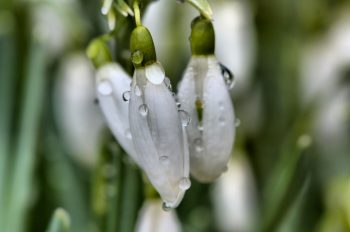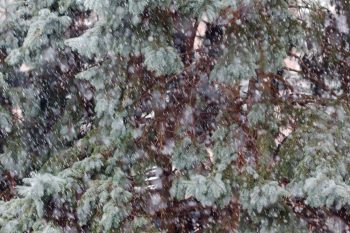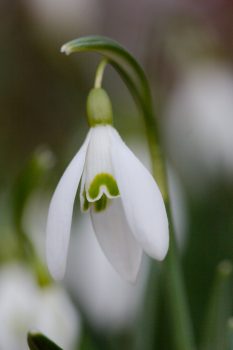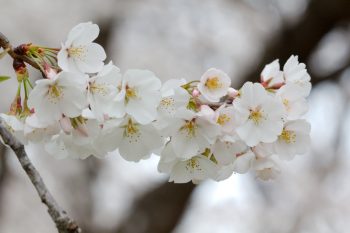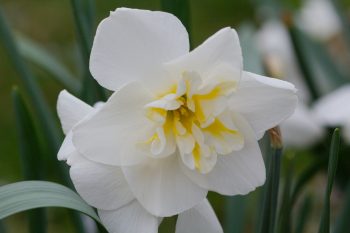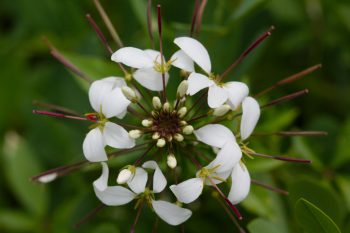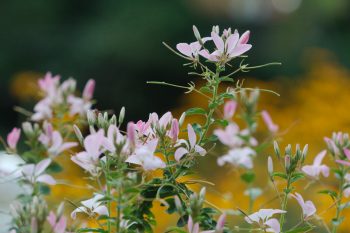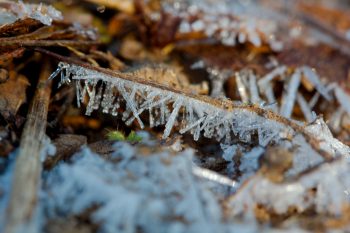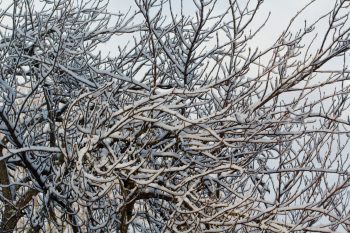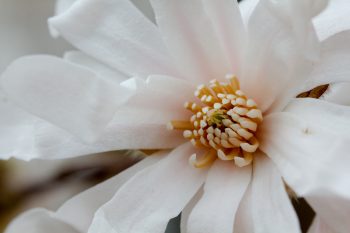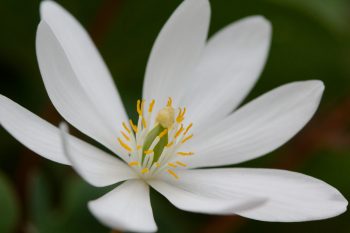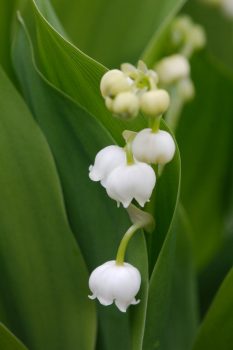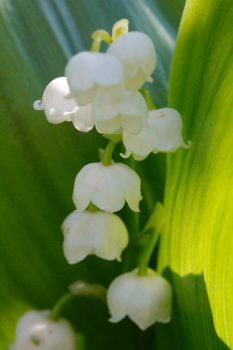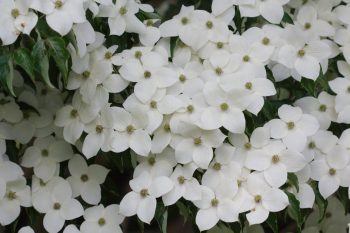The snow drops (Galanthus nivalis) along the edge of the woods near my office have been in bloom for a week or more. Those in our yard are in a more sheltered spot and tend to bloom later but they are coming out now. Early this afternoon I decided to take some pictures of them with snow all around them. I got a few like that but decided I like this close up better, even though it doesn’t show the snow. They’re not really open in this picture but they open up on warm days before closing up at night. With yesterday’s snowfall, they have gone back into winter mode but it won’t be long before they are open for good. The daffodils are also coming up and showing signs of buds in amongst the leaves. It’s still winter here, but spring is coming.
Tagged With: White
Snow Drops
A Little Light Snow
There was snow in the forecast for this afternoon and this evening and we got it. Someone had said that we’d be getting two feet of snow, but nothing approaching that was ever in any official forecast that I saw. We got somewhere under a half inch and that only on grassy areas. The roadways we were on never had any accumulation. It’s also supposed to be colder this week, with temperatures in the mid 20s or even down into the teens one or two nights this week. The forecasters on the radio are breathlessly telling us about the “bitter cold“ weather we can expect. I’m sorry but I can’t get too exercised about temperatures around 20°F. I wouldn’t describe that as warm, of course. It’s cold, but definitely not “bitter cold.“ I’m happy with anything below zero being described as bitter. I might even grant “bitter“ status to single digit temperatures. But not low to mid twenties. Sorry.
Snow Drops (Galanthus nivalis)
I know I posted a picture of snow drops (Galanthus nivalis) on Saturday, March 02, 2019 but the flowers were not really open then and they are now. Our yard is fairly shady and the spring blooms seem to be a week or so behind those that get full sun. We have a few clmps of snow drops in the yard. Those I photographed last time are by the sidewalk. These are in the back yard. They are certainly a welcome sign of spring, often blooming when there is still snow on the ground (thus the name, I assume). I love the little touch of green on the central part of the flower. Green is fairly uncommon as a flower color, I assume because it’s so common on the leaves themselves. But it makes a nice change.
The snow drops are generally followed by the winter aconite (Eranthis hyemalis) and the Lenten rose (Helleborus species). One Lenten rose is already blooming but the others are just starting to come out. I suspect I’ll have more pictures of them soon.
More Cherry Blossoms
The cherry blossoms have really come out in force this week and my understanding is that the trees around the tidal basin downtown are in full bloom. They’re worth a visit but it can be quite an ordeal to get down there. Parking is generally impossible anywhere near the tidal basin so it’s much better to take the subway and just resign yourself to the fact that you’re going to do a bit of walking. They really are worth it. We haven’t been in quite a few years and this photo was taken beside one of the buildings on our company’s campus, rather than down town. As you can see, the flowers are white and there is only a hint of pink in the buds. Some have a little more pink than this but the cherries are not nearly as colorful as the crab apples, which I actually prefer by a wide margin.
Narcissus ‘Lemon Beauty’
The daffodils are about at their peak right now and will soon begin to fade. We have a few that are still getting ready to bloom for for the most part, they are open. These ‘Lemon Beauty’ daffodils were planted in the fall of 2014 so this is their fifth spring and they are doing quite well. They were planted in the bed around the Colorado spruce and were somewhat shaded by that but now that it’s gone, they’ll get more early spring sun, which they will appreciate, I suspect. The stump of the spruce is still there and I need to finish getting that up and then decide what to plan in its place. I’ve narrowed it down to a half dozen flowering trees but making the final decision is hard.
Lily of the Valley
The lily of the valley (Convallaria majalis) is starting to bloom. This is a great, little ground cover once it gets itself established. That can take a little while and they aren’t cheap when you buy them from the garden center a few pips at a time. They also have a tendency to “migrate” in the garden. In our back yard they are around the two smaller maple trees that we still have. Over the time we’ve been here they have expanded and died out in the central part of the bed. I wish you could make it “turn around” and head in the other direction but short of digging it up and physically turning it around, that’s not really possible.
The flowers don’t last very long but while they are blooming they are really pretty. Note that all parts of the plant are poisonous, containing cardiac glycosides, so don’t try to use them as a salad green. I don’t think that’s something I’d have thought to try anyway.
Cleome ‘Senorita Blanca’
On Sunday, as I mentioned, we went to Stadler Nursery in Laytonsville. Cathy bought a few things, including two Cleome plants, one white and one very pale pink. The white one, shown here, is called ‘Senorita Blanca’ and the other is ‘Senorita Mi Amor’. We’ve had Cleome ‘Senorita Rosalita’ in the past and these are (I assume) related plants with different coloration. My understanding is that they are sterile and will not self-seed, which is both good and bad. Annuals that do self-seed can become a real nuisance and get out of control. But some, if they only just manage to hold on, are really nice. Nigela is a good example of the latter. In our experience, it just self-seeds enough that we have it for a few years before needing to plant more. Other annuals, of course, go totally native and sterile plants are a real boon.
Northern Flatid Planthopper (Flatormenis proxima)
I took a few pictures of butterfly weed flowers this evening and I might have posted one of them. A little later I noticed this white leafhopper and got a few pictures of it, including this reasonably sharp image. Getting a good picture was made more difficult by the breeze, which was moving the stem the planthopper was on, but this one turned out pretty well. It was sharp enough for it to be identified as a northern flatid planthopper (Flatormenis proxima), one of our more common planthoppers. They do little damage and I left him alone to get what he needed from this plant.
Cleome ‘Senorita Blanca’
My back was up to a full day’s work today. Although there were a few rough spots I made it through, trying to get up now and then to move around (because “Motion is Lotion” as they say). When I got home I took pictures of various flowers in the back yard. I really thought it would be pushing it to get down on the ground for photography. I did for the caterpillar photo yesterday but getting back up was a chore. So, I sat in a chair and photographed what was all around, including blue Lobelia, butterfly weed, Lantana, and a few other flowers. I like the Cleome with the black-eyed Susan flowers behind it.
Frost
It’s turned cold, with morning temperatures in the mid 20s. We had our first hard freeze yesterday and today there was frost on the windscreen of my car. So, naturally I pulled out my camera and took a few pictures. These little ice crystals are pretty delicate and once I turned on the car, they melted pretty quickly (and I ran the windshield washer, which took care of them completely). As many of you know, I don’t mind cold weather too much. I wore a jacket a few times during our ten days in Juneau but that was as much for the rain as anything else. I’ll generally not bother unless it’s below about 15°F or I’m going to be outdoors for an extended period.
Frost
There was a heavy frost this morning and I took the time before going to work to get some photos. That meant lying on the ground which was a bit cold and decidedly damp, but I knew I’d dry out before I got to work, so I wasn’t worried. I think ice crystals are pretty cool (no pun intended) and these are pretty nice. I’d like to have gotten closer but I didn’t have the time to get out the ultra-close-up equipment, so this was about as good as I could get.
Yesterday’s Snow
After yesterday’s snowfall, today promised to be quite nice. Cool but clear. There were still some clouds when we left for work today but between them, the sun was shining and making all the show quite dazzling this morning. I really like snow on branches and took quite a few photos this morning before we left for work. As mentioned yesterday, local schools were on a two hour delay so we didn’t have any problems with traffic. The roads were all clear and mostly dry, although it’s my understanding that in the northern and western parts of the county it was a bit icier. This wasn’t the sort of snow storm that paralyzes the region. We still have plenty of time this winter for something like that, though.
Star Magnolia
The star magnolia (Magnolia stellata) is a really nice flowering tree, relatively slow growing but eventually getting up to about 20 feet tall and nearly as wide. It flowers rather early in the spring and it’s not uncommon, at least here, for the blooms to be killed by a late frost. We’ve been spared that this year and they are blooming all over right now. The generally later saucer magnolia (Magnolia × soulangeana) is starting to bloom around the neighborhood, also. There are some cherries blooming and the daffodils are coming out in great numbers. It’s a pretty time of year.
Spiraea prunifolia
Our spiraea is in bloom and it’s really pretty as a background plant. It’s flowers are small but borne in a profusion of white. There are little bits of green in the flowers, but that can really only be seen close up. Spiraea prunifolia, bridal wreath spiraea, is a native of China, Japan, Korea, and Taiwan and has been introduced in much of eastern North America. Interestingly, this double-flowered plant has the species name while the single-flowered variety, discovered later, is classified as a variety or form of the species. The name of the genus Spiraea comes from the Greek word speira meaning wreath.
Daffodil ‘Actaea’
This is a daffodil called ‘Actaea’, which is in the poeticus division (division 9), which are distinguished by their large white petals and small, dainty cups in contrasting colors. I think they are fairly posh, compared to their more boisterous cousins but they are similar in their hardiness. They are a bit slower to produce large clumps, though, so if you want a lot of them in a hurry, you’ll want to plant more of them up front. The stems on these are a little less rigid than the others, as well, and they have a tendency to droop even more when it rains but in the sun, they are hard to beat.
Sanguinaria canadensis (Bloodroot)
Another photo from our trip to the Montgomery County Agricultural History Farm Park on Muncaster Road. Bloodroot (Sanguinaria canadensis) has very pretty, pure white flowers that don’t last very long. I love them as a true sign of spring. There are some places where you see this native plant in the woods one day as you drive by and then it’s gone the next. The plant is still there, obviously, but not so obvious without it’s bright blooms. The leaves are quite interesting, being deeply-scalloped. The leaves continue growing after the blooms are gone, and are present until mid to late summer when the plant goes dormant.
Lily of the Valley (Convallaria majalis)
The lily of the valley (Convallaria majalis) is starting to bloom. We have it in a few places around the yard and these are at the front corner of our house where they get just a bit more sun than the other places so are a little ahead. It’s a lovely plant and has lovely, sweetly fragrant flowers but all parts of the plant are very poisonous so if that makes you nervous, you might want to avoid it. It contains cardiac glycosides, “a class of organic compounds that increase the output force of the heart and increase its rate of contractions.”
We dug some up in a yard that was being torn up when a road was being widened and it was growing through asphalt paving, so it’s pretty tenacious. We have it in a fairly large bed in the back yard but it is actually being forced outward by Vinca minor which I wouldn’t have thought possible.
White Flowering Clematis
In the back of our garden, near the fence where there was a huge rose bush, there is a clematis. For years it’s struggled to be seen among the rose, which was often out of control. Well, the rose is gone now, having mysteriously died last year. I’m sad about that, and wish it hadn’t died but at least this beautiful, white clematis is still there and is doing quite well, now that it’s getting the sun it needs and isn’t overshadowed by the huge plant. We will need something for it to clime on but for now, it’s just happy to be blooming in the sun.
Lily of the Valley (Convallaria majalis)
I know I’ve already had a picture this spring of the lily of the valley (Convallaria majalis) from our garden but it’s blooming so well and so long that I thought I’d share another. We’re also in a little lull where there isn’t a lot new coming out, although it’s still changing. So, here’s another view of the little white bells of the lily of the valley, this time from the back garden, near the fence (not that it makes much difference, of course). Soon the flowers will be gone and even the leaves will fade in the coming heat of summer. We are near the southern limit of where it grows well. If you grow it here, it needs some shade to protect it from the heat of the summer sun but further north it does well in full sun.
We also have a terrific crop of Canadian thistle (Cirsium arvense) coming up among it (and many other places, as well) and it really needs to be dealt with. That’s a really problematical weed, having “a deep and wide-spreading root system with a slender taproot and far-creeping lateral roots.” (Source: Fire Effects Information System, US Forest Service). That same document also says that “new plants can also form from root fragments as short as 0.2 inch (6 mm),” which helps explain why it’s so hard to get rid of.
Kousa Dogwood
It’s kousa dogwood (Cornus kousa) time in the neighborhood. These trees bloom later than the native flowering dogwood (Cornus florida) and in general have fewer problems here. They make quite handsome trees of a good size for a suburban yard. They flowers are followed by interesting fruit so they have two seasons of interest, which is nice. They also have interesting bark. The main thing, though, is that they aren’t killed by dogwood anthracnose, which is pretty hard on the C. florida trees. C. kousa is also a bit hardier, although that’s not a real issue here. But the disease problem really is.

